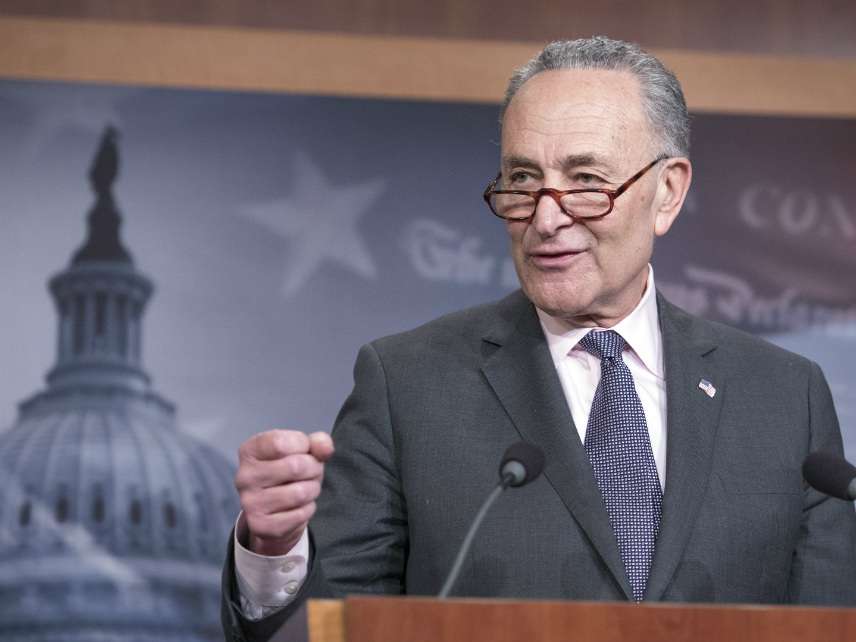Senate Dems Infrastructure Plan: A Tale of Tax Hikes and Transit Subsidies
The plan calls for $1 trillion is spending on everything from walking trails to high-speed internet.

Senate Democrats released their own infrastructure plan this week. It is both terribly conventional and just plain terrible.
The so-called "Jobs & Infrastructure Plan for America's Workers" promises $1 trillion in direct federal spending—not just on traditional infrastructure line items, such as highways, bridges, and ports, but also on schools, housing, and high-speed internet.
"Our plan would create more jobs than the administration plan, build more projects, and build the infrastructure America actually needs, not just what crony donors and private investors can profit from," said Sen. Chuck Schumer (D–N.Y.).
That White House proposal would spend $200 billion in federal funds with the hopes of spurring an additional $1.3 trillion in state, local, and private investment, while streamlining the federal permitting process and doing away with regulations that discourage the use of user fees and private infrastructure provision. The Democratic plan would instead overturn a host of recent tax cuts to fund a federal infrastructure spending binge while attaching even more regulations to that spending.
Their plan calls for jacking up the corporate tax rate from 21 percent to 25 percent, raising the top income tax bracket back to 39.6 percent, and scrapping changes that the Republican tax bill made to the Alternative Minimum Tax and the Estate Tax. This, Democrats claim, will add up to a little more than $1 trillion in tax increases over 10 years.
A good portion of this would go toward what people might traditionally think of when hearing the word "infrastructure." This includes $115 billion for water and sewer systems and $140 billion for roads. Some $40 billion of that road money would go toward building and repairing the nation's bridges, with another $100 billion being spent on highways. An additional $140 billion would be put into the Highway Trust Fund.
Transit spending and grant programs would also get a big boost, with $115 billion going toward a plan to "repair and improve public transportation." This would see federal taxpayers shelling out more for even the most routine local transit expenditures, including $30 billion for new buses and rail cars, $15 billion for "urgent repair projects," and a $35 billion boost to grant programs that fund everything from maintenance to transit security.
The feds would also pony up another $3 billion to build recreational trails, bike paths, and other infrastructure for bicyclists and pedestrians.
A lot in the Democratic proposal is at best tangentially connected to infrastructure. This includes $50 billion in aid to local school districts and community colleges, $62 billion for affordable housing and "neighborhood revitalization" (including a call to expand the scandal-ridden Low-Income Housing Tax Credit program), and $40 billion for a "universal internet grant program."
This raises the hackles of some pro-market transportation experts, including Baruch Feigenbaum of the Reason Foundation, the nonprofit that publishes this website. Truly federal priorities "like the interstate system, and the major arterial roads, the national highway system in the U.S., are incredibly expensive," says Feigenbaum. It's better for scarce federal transportation dollars to go there, he says.
The fact that Democrats are in the minority encourages lavish proposals like the ones in this document. When you don't control the levers of power, it's a lot easier to escape blame for not following through on your promises. But since the Trump administration will likely need some bipartisan backing to get his infrastructure proposal through Congress, the Democratic proposal may serve as an outline of the kinds of concessions that will be necessary to secure their support.
Says Feigenbaum, "The president laid out his vision. Now the Democrats are laying out their vision. The reality is its going to be something in the middle."
Rent Free is a weekly newsletter from Christian Britschgi on urbanism and the fight for less regulation, more housing, more property rights, and more freedom in America's cities.


Show Comments (55)